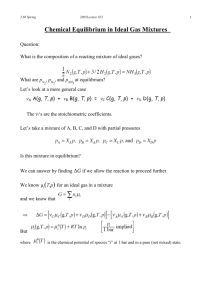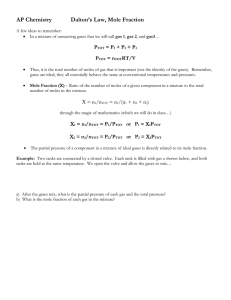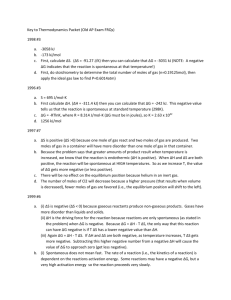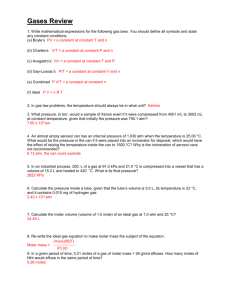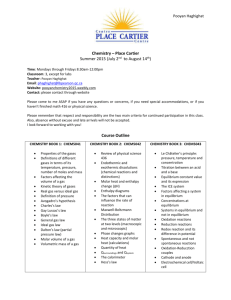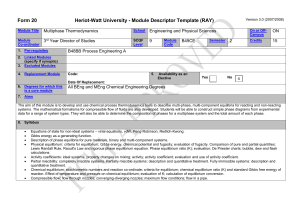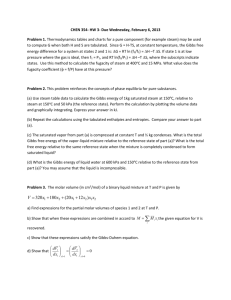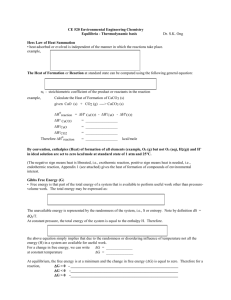Relation between equilibrium constant and Gibb`s free energies
advertisement
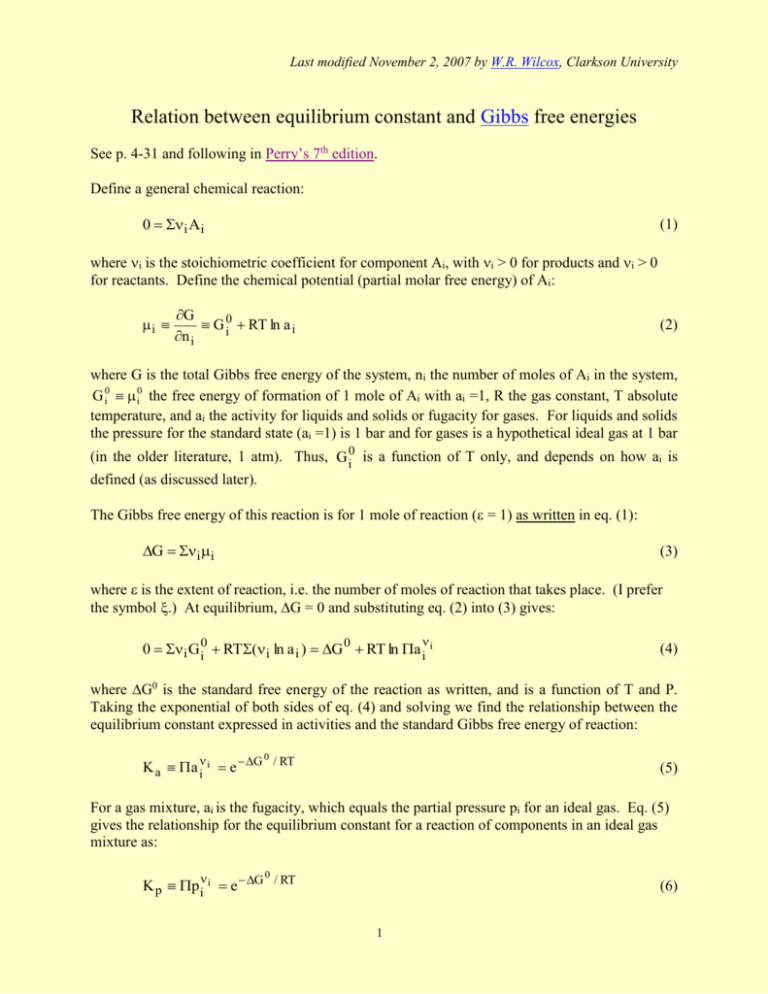
Last modified November 2, 2007 by W.R. Wilcox, Clarkson University Relation between equilibrium constant and Gibbs free energies See p. 4-31 and following in Perry’s 7th edition. Define a general chemical reaction: 0 i A i (1) where i is the stoichiometric coefficient for component Ai, with i > 0 for products and i > 0 for reactants. Define the chemical potential (partial molar free energy) of Ai: i G G i0 RT ln a i n i (2) where G is the total Gibbs free energy of the system, ni the number of moles of Ai in the system, G i0 i0 the free energy of formation of 1 mole of Ai with ai =1, R the gas constant, T absolute temperature, and ai the activity for liquids and solids or fugacity for gases. For liquids and solids the pressure for the standard state (ai =1) is 1 bar and for gases is a hypothetical ideal gas at 1 bar (in the older literature, 1 atm). Thus, G i0 is a function of T only, and depends on how ai is defined (as discussed later). The Gibbs free energy of this reaction is for 1 mole of reaction ( = 1) as written in eq. (1): G i i (3) where is the extent of reaction, i.e. the number of moles of reaction that takes place. (I prefer the symbol .) At equilibrium, G = 0 and substituting eq. (2) into (3) gives: 0 i G i0 RT ( i ln a i ) G 0 RT ln a i i (4) where G0 is the standard free energy of the reaction as written, and is a function of T and P. Taking the exponential of both sides of eq. (4) and solving we find the relationship between the equilibrium constant expressed in activities and the standard Gibbs free energy of reaction: 0 K a a i i e G / RT (5) For a gas mixture, ai is the fugacity, which equals the partial pressure pi for an ideal gas. Eq. (5) gives the relationship for the equilibrium constant for a reaction of components in an ideal gas mixture as: 0 K p p i i e G / RT (6) 1 where pi yiP is the partial pressure of Ai in the gas mixture at total pressure P with mole fraction yi. If one wishes to express the equilibrium constant in terms of molar concentrations, Ci = pi/RT, then p i i RT i Ci i and: K C C i i Kp (7) RT i Thus the temperature dependence of KC must be different than that of Kp unless i = 0, i.e. the number of moles of gaseous product are the same as the number of moles of gases reactant. See any chemical thermodynamics text for conditions for the standard state (with ai = 1) for G i0 . For gases, for example, the standard state is pure Ai at standard pressure with the properties of an ideal gas. Until recent years the standard pressure was 1 atm, while now it is usually taken to be 1 bar. One must make a suitable correction when using data from two sources, one with a standard pressure of 1 atm and the other using 1 bar. The partial pressures used in equation (6) and the units for R must be that same as the standard pressure used for the values of G i0 . By taking the natural logarithm of both sides of equation (6) for an ideal gas mixture, one might expect a plot of ln(Kp) versus 1/T would give a straight line of slope -G0/R and an intercept of 0 (Kp 1 as T ). However, this ignores that fact that G0 is a function of T. While such plots are very nearly linear, they are not exactly so and their intercepts are not 0. To obtain an approximate interpretation of such a plot we note that G0 = H0 - TS0 (8) where H0 is the enthalpy of formation and S0 is the entropy of formation. While H0 and S0 are also temperature dependent, they are only slightly so. Substituting equation (8) into equation (6) and taking natural logarithms we find: ln K p H 0 S0 RT R (9) Thus, the slope of a ln(Kp) versus 1/T plot is best interpreted as -H0/R and its intercept as S0/R. Inserting equation (7) into equation (9) we obtain for the concentration-based equilibrium constant KC of an ideal-gas reaction: H 0 S0 ln K C i ln RT RT R (10) For non-ideal liquid mixtures, ai = ixxi or iCCi, where i is the activity coefficient, xi is the mole fraction of Ai in the mixture, and Ci is either its molal concentration (mol/kg solvent) or molar concentration (mol/m3). Note that i is really defined by this relationship, i.e. the constant that when multiplied by the concentration gives the activity. For compounds that are liquid at the specified temperature, ai = 1 corresponds to xi = 1, i.e. ix 1 at xi = 1. For compounds that 2 must be dissolved, iC is defined as 1 for infinite dilution, i.e. the limit as Ci 0. Electrolytes: For electrolytes that dissociate to ions in solution, one must use a different expression for Equation 2 and all that follow from it. Thus, for a compound i for which each molecule dissociates completely into + positive ions and - negative ions1: i i0 RT ln m i (11) where = + + - is the total number of ions from each molecule of i, mi is the molal concentration of i in the solution, and coefficients of the positive and negative ions. 1 1/ is the geometric mean of the activity Thermodynamics, 2nd edition, G.N. Lewis, M. Randall, K.S. Pitzer, L. Brewer (McGraw-Hill, NY, 1961) pp 311 & 333. 3
